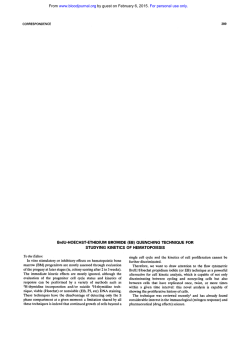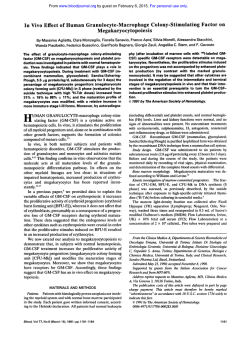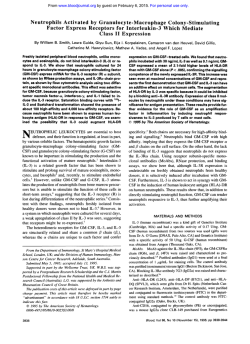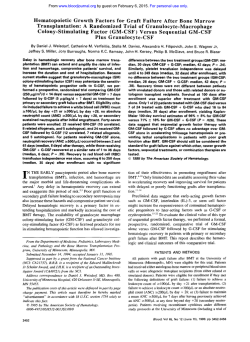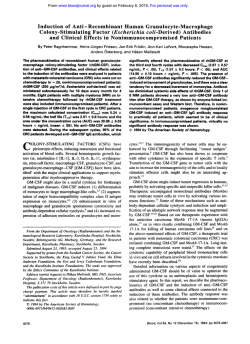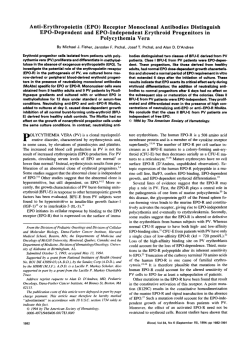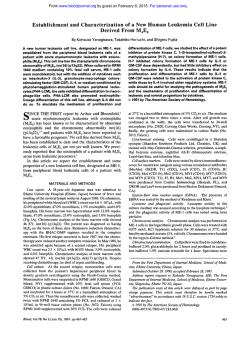
c-kit Ligand Reactivates Fetal Hemoglobin Synthesis in
From www.bloodjournal.org by guest on February 6, 2015. For personal use only. c-kit Ligand Reactivates Fetal Hemoglobin Synthesis in Serum-Free Culture of Stringently Purified Normal Adult Burst-Forming Unit-Erythroid By C . Peschle, M. Gabbianelli, U. Testa, E. Pelosi, T. Barberi, C . Fossati, M. Valtieri, and L. Leone We have analyzed the reactivationof fetal hemoglobin (HbF) synthesis under rigorous in vitro conditions, ie, in mature erythroblasts generated by erythroid burst-forming units (BFU-E) stringently purified from normal adult peripheral blood and grown in fetal calf serum (FCS)-freesemisolid or liquid phase culture. In clonogenetic dishes, graded amounts of c-kit ligand (KL) were added together with saturating levels of erythropoietin (Ep) and variable amounts of interleukin-3 and granulocyte-macrophage colony stimulating factor (IL-3/GM-CSF), ie, high or low level, or no IL3/GM-CSF addition. In all conditions, KL induced a sharp, dose-dependent increase in the percentage of F cells and HbF content from nearly normal levels ( 4 0 %and <2.5%, respectively, at 0.1 and 1 ng/mL) up t o 40%to 50%and 10%to 15% at 100 t o 200 ng/mL. This increase was not associated with significant differences of burst number or stage of maturation at the time of analysis (as evaluated on the basis of percent mature erythroblastsand Hb content per cell). However, the KL-induced reactivation of HbF synthesis was strictly and directly correlated with a sharp increase of colony size, ie, cell number per burst. Addition of large amounts of IL-3 and GM-CSF (10 to 100 U and 1 t o 10 ng/mL, respectively) significantly potentiated the KLinduced reactivation of HbF. as compared with low levels (0.1 U and 0.01 to 0.1 ng) or no addition of these growth factors: this increase was highly significant at low KL doses (ie, 1 to 10 ng/mL). Single-burst analysis showed that the KL-induced HbF reactivation occurs homogeneously in the erythroid colonies within each of these culture conditions. We have analyzed the effect of KL in liquid phase BFU-E culture treated with the IL-3/GM-CSF/Ep combination at sequential times until terminal erythroid maturation: KL causes a sharp increase in the percentage of F cells and HbF content in all stages of maturation, whereas the IL-3/ GM-CSF/Ep combination alone has a markedly lower effect. These results suggest that KL plays a key role in the reactivation of HbF synthesis in adult life, whereas IL-B/GMCSF potentiate this effect at low KL levels. The KL-induced HbF reactivation is seemingly related t o an enhanced proliferation of erythroid progenitors in the erythropoietic differentiation pathway. 0 1993 by The American Society of Hematology. I ually and almost totally replaced by the program for HbA (and some A2)production in the perinatal However, the potential for significant HbF synthesis is maintained in all postnatal BFU-E.6*7 It is noteworthy that in the erythroblast differentiation pathway the synthesis of y-chains peaks earlier than the production of y-globin in fetal,’ perinatal, and adult12 life. It follows that modulation of HbF/A synthesis and content should be evaluated in erythroblast populations at a comparable maturation stage. The mechanism(s) underlying reactivation of y-globin synthesis in normal adult bursts grown in FCS* cultures has been intensively investigated. We reported that the HbF reactivation is markedly diminished in FCS- culture conditions, which show nearly normal levels of y-chain synthesis.” This phenomenon, confirmed by other investigator^,'^.^^ may be attributed to HbF-reactivating factors either present in FCS” or released by accessory cells in FCS’ c~1ture.l~ In this last regard, addition of exogenous granulocyte-macrophage colony-stimulating factor (GM-CSF)I3 or interleukin-3 (IL3)16to FCS- semisolid cultures induces reactivation of HbF synthesis up to the level observed in FCS+ dishes. In standard FCS+ cultures seeded with nonpurified adult blood BFU-E, accessory cells produce a variety of cytokines (eg, IL-3 and GM-CSF) at levels of biologic significance.” It seems necessary, therefore, to evaluate the effect of exogenous cytokines on HbF reactivation in the absence of accessory cells releasing endogenous growth factors. In this regard, we have reported methodology allowing complete purification and abundant recovery of early hematopoietic progenitors from normal adult peripheral blood (PB).18 The present studies describe the effect of c-kit ligand (KL), combined with a saturating level of Ep and variable amounts of IL-3/GM-CSF, on HbF production in mature erythroblasts generated by “pure” adult blood BFU-E in FCS- semisolid N THE PERINATAL PERIOD, fetal hemoglobin (HbF; cr2y2)is subtotally replaced by adult hemoglobin (HbA; 01~82)and some HbA2 (a2S2). Thereafter, HbF (<1% of total Hb) is restricted to F cells, which represent less than 6% of red blood cells (RBCS).’.~ In a variety of postnatal conditions, particularly in rapid marrow regeneration (stress erythropoiesis), HbF synthesis may be reactivated up to 10%to 20% relative y-globin content.334A similar reactivation has been observed in vitro: in fetal calf serum-supplemented (FCS’ ) semisolid cultures treated with erythropoietin (Ep), nonpurified erythroid burst-forming units (BFU-E) from normal adults generate erythroblast colonies (bursts) with a marked enhancement of relative y-chain synthesis (ie, 10%to 2O%),’ as compared with corresponding in vivo levels (<2% to 3%). Evaluation of globin production in single BFU-E-derived clones showed that all normal adult bursts synthesize a significant amount of y - ~ h a i n s .These ~ , ~ results, coupled with a similar analysis of single bursts from yolk sac,8 embryonic or fetal liver,*,’ and cord bloodlo.” indicate that postembryonic BFU-E are always bipotent for HbF and A synthesis. The HbF potential obviously prevails in fetal life, but is gradFrom the Department of Hematology-Oncology, Istituto Superiore di Sanitd, Rome; and Regina Margherita Hospital, Turin, Italy. Submitted March 27, 1992; accepted September 10, 1992. Supported in part by the program “Terapia dei Tumori, Istituto Superiore di Sanitd, Rome, Italy. Address reprint requests to C. Peschle MD, Department of Hematology-Oncology, Istituto Superiore di Sanitd, Viale Regina EIena 299, 00161 Rome, Italy. The publication costs of this article were defiayed in part by page charge payment. This article must therefore be hereby marked “advertisement” in accordance with 18 U.S.C. section 1734 solely to indicate this fact. 0 1993 by The American Society of Hematology. 0006-4971/93/8102-0012$3.00/0 ” 328 Blood, Vol81, No 2 (January 15). 1993: pp 328-336 From www.bloodjournal.org by guest on February 6, 2015. For personal use only. 329 KL AND HeF REACTIVATION or liquid-phase culture. HbF levels were evaluated in terms of percentage of F cells and HbF content by immunofluorescence and high-performance liquid chromatography (HPLC) analysis, respectively. In addition, a variety of parameters were monitored to rigorously control these experiments, ie, erythroblast maturation and Hb content per cell, as well as burst number and colony size in semisolid culture and cell and progenitor number in liquid phase conditions. MATERIALS AND METHODS Hematopoietic growthfactors. Recombinant human IL-3 (specific activity, 2 to 4 X lo6 U/mg) and GM-CSF (1.7 X lo7 U/mg) were supplied by Genetics Institute (Cambridge, MA). Recombinant human Ep ( 1.1 X lo5 U/mg) and KL (r1 X lo5 U/ng) were provided by Amgen (Thousand Oaks, CA) and Immunex (Seattle, WA), respectively. PB. Adult PB was obtained from healthy adult male donors after informed consent. Blood (450 mL) was collected in preservative-free citrate/phosphate/dextrose/adenine(CPDA-1) anticoagulant. A bu@ coat was obtained by centrifugation (Beckman J6M/E, 1,400 rpm/ 20 minutes at room temperature; Beckman Instruments Inc, Fullerton, CA). Progenitor puriJication. Cells were purified by a four-step procedure slightly modified from Gabbianelli et al.". Briefly, (IA) adult PB buffy coats were separated over a Ficoll-Hypaque density (d) gradient (d = 1.077) (Pharmacia Fine Chemicals, Piscataway, NJ).I9PB mononuclear cells (PBMCs) were collected, washed twice, and resuspended in Iscove's modified Dulbecco's medium (IMDM; GIBCO, Grand Island, NY). (IB) PBMCs were resuspended in IMDM containing 20% heat-inactivated FCS (GIBCO) and treated with three cycles of plastic adherence. (11) Cells were washed and resuspended in IMDM with 10% FCS, and separated by centrifugation (600 g for 30 minutes at 20°C) on a discontinuous Percoll (Biochrom KG, Berlin, Germany) four-step gradient (d = 1.052, 1.056, 1.060, 1.065). (111) Low-density cells (d = 1.052 and 1.056),containing the majority of hematopoietic progenitors, were collected, washed three times in IMDM supplemented with bovine serum albumin (BSA; 2 mg/mL, Fraction V, 96%to 99%purified, Sigma, St Louis, MO), and incubated for 60 minutes at 4°C with appropriate amounts of the following monoclonal antibodies (MoAbs): OKT3, OKT4, OKT8, OKTl1, OKT16, OKMl, and OKM5 (Ortho, Raritan, NJ); and Leu7, Leu9, Leu1 1, Leul2, Leul4, Leul9, LeuM1, and LeuM3 (Becton Dickinson, Oxnard, CA). Cellswere then incubated with immunomagnetic monodisperse microspheres coated with sheep antibody to mouse IgG and IgM (Dynabeads M450, diameter 4.5 pm, 1.3 X lo7 particles/ mg; Dynal, Oslo, Norway). The beads, together with rosetting cells, were then retained along the tube wall with a magnet and the supernatant fluid containing negative cells was recovered. (IV) After overnight incubation at 37°C in IMDM/20% FCS, cells were incubated for 60 minutes at 4°C in the presence of an appropriate amount of two anti-CD34 MoAbs (HPCA-I, 30 pL/l X lo6 cells [Becton Dickinson], and BI-3C5, 10 pL/l X lo6 cells [Sera Lab]), washed three times in cold IMDM/BSA (2 mg/mL), and incubated for 90 minutes at 4°C in the same medium containing immunomagnetic monodisperse microspheres coated with sheep antibody to mouse IgG and IgM (Dynabeads M450). The beads, together with rosetting cells (CD34+),were then retained along the tube wall with a magnet; the supernatant fluid containing negative cells was discarded and the beads washed with 1 mL of IMDM/BSA. The rosetting cells were counted and cultured either in semisolid medium for clonogenic assays or in liquid suspension. Methylcellulose culture. For FCS+ cultures,18PBMCs were cultured at a concentration of 3 X IO5 cells/mL/dish (two plates per point) in 0.9% methylcellulose, 40% FCS, and 3 U/mL Ep in IMDM supplemented with alpha-thioglycerol ( mol/L) (Sigma) at 37°C in a 5% C02/5% Od90% N2humidified atmosphere. Step IV-purified hematopoietic progenitors (1 X 10' cells/mL/dish) were plated in the presence of saturating level of Ep (3 U/mL), variable amounts of GM-CSF and IL-3, and graded concentrations of IU. For FCS- cultures,'8.20in most experiments FCS was substituted by BSA (10 mg/mL), pure human transferrin (0.7 to 1 mg/mL), human lowdensity lipoproteins (40 pg/mL), insulin (10 pg/mL), sodium pyruvate ( mol/L), L-glutamine (2 X lo3 mol/L), rare inorganic elements2' supplemented with iron sulphate (4 X lo-' mol/ L), and nucleosides (10 pg/mL of each). Liquid phase culture. Step I11 or IV progenitors were grown in FCS- IMDM (1 to 5 X lo4 step IV, 5 lo5 step 111 cells/mL), supplemented with bovine serum albumin (BSA), human transferrin, human lowdensity lipoproteins, insulin, sodium pyruvate, L-glutamine, rare inorganic elements, nucleosides, and human recombinant hematopoietic growth factors (HGFs) (0.01 U/mL IL-3,O.OOl ng/mL GMCSF, and 3 U/mL Ep k 10 ng/mL KL)?' The cells were split when they reached 7 X lo5 cells/mL. Cultures were incubated in a fully humidified atmosphere of 5% C o d s % 02/90% N2. F cell analysis. The percentage of erythroblasts containing HbF was evaluated by indirect fluorescence as described previo~sly.~~ Briefly, cells from pooled or single bursts'' were cytocentrifuged on a glass slide, fixed for 5 minutes at room temperature in acetone: methanol (9: 1, vol/vol), washed three times with phosphate-buffered saline (PBS), once with PBS containing 2 mg/mL BSA, and incubated for 40 minutes at 37°C with a 1:20 dilution of an antihuman HbF MoAb (Labometrics, Milan, Italy). The slides were washed twice with PBS, once with PBS/BSA, incubated for 30 minutes at room temperature with a 1:20 dilution of F(ab')2 antimouse IgGs (Dakopatts, Copenhagen, Denmark), and extensively washed in PBS. The slides were then mounted in PBS/glycerol (5050, vol/vol) and observed under an Axiophot Zeiss microscope equipped for fluorescence. As a negative control, cells were incubated with mouse IgG instead of anti-HbF and processed as above. Relative HbF content. HPLC separation of globin chains was performed according to Leone et al," with minor modifications. Briefly, cell lysates were separated on chromatographic columns (Merck LiChrospher 100 CH8/2, 5 pm; E. Merck, Darmstadt, Germany) using as eluents a linear gradient of acetonitrile/methanol/ 0.155 mol/L sodium chloride (pH 2.7, 68:428 vol/vol/vol) (eluent A), and acetonitrile/methanol/O.777mol/L sodium chloride (pH 2.7, 21:38:41 vol/vol/vol) (eluent B). Gradient was from 19% to 50% eluent A in 60 minutes at a flow rate of 0.8 mL/min. The optimal absorbance of the different globins was evaluated at 2 15 nm, because the absorbance coefficients of the different chains are identical at this ~avelength.2~ Total Hb content per cell was evaluated as previously described.13 Morphology analysis. Cells were harvested at different days, smeared on glass slides by cytospin centrifugation, and stained with May-Griinwald Giemsa. RESULTS Preliminary studies on PBMCs (ie, nonpurified PB BFUE) grown in standard methylcellulose cultures (Fig 1 and results not shown) confirmed that in FCS+ medium erythroid bursts exhibit a high level of F cells (35% to 40%) and HbF content (20% to 25%), whereas colonies generated in FCSconditions show markedly lower values (4% and <2%, respectively). Interestingly, the number of bursts was similar in both FCS+ and FCS- cultures, whereas their size was apparently more elevated in FCS+ than in FCS- conditions. From www.bloodjournal.org by guest on February 6, 2015. For personal use only. 330 PESCHLE ET AL FCS+ J n t P t t GY Au t P t t GY Au Fig 1. Representative globin chain HPLC scans from PBMCgenerated erythroid bursts grown in FCS' (left) or FCS- (right) cultures. From left to right, the peaks correspondto heme, pre-l, l(as indicated), 6, a,Oy, andy' (both are indicated) globin chains. A large series of experiments was then performed to investigate HbF synthesis and content in normal adult erythroid bursts generated by BFU-E stringently purified from PB and grown in FCS- culture. The clonogenetic and immunophenotypic features of the pure progenitor population have been Briefly, this homogenous population comprises early erythroid (BFUE), GM (CFU-GM), and multipotent (CFU-GEMM) progenitors, which are largely quiescent and exhibit a CD34+lin-, mostly CD33-/45RO- phenotype. The purified PB BFU-E apparently represents the counterpart of early bone marrow BFU-E, which is admittedly CD34+33-,25whereas more differentiated bone marrow progenitors are CD34+/33+/ 45R0+.26*27 Indeed, differentiation in culture of purified PB BFU-E is followed after 3 to 5 days by expression of CD33 and CD45RO antigensz2 As shown in Fig 2A, addition of graded amounts of KL to FCS- methylcellulose culture of stringently purified BFUE (100 cells/dish) causes a slight, nonsignificant increase of burst number, but also a striking increase in the size of BFUE colonies, particularly in the range of 1 to 100 ng/mL KL, ie, from fewer than 5,000 cells per colony to approximately 50,000 cells per colony. Accordingly, the maturation of KLtreated bursts is delayed when compared with control bursts. To compare KL-treated and control bursts at the same stage of erythroblast maturation, bursts from control plates were picked up for analysis starting from day 16, whereas those from KL-treated dishes were analyzed from days 19 to 20. In both groups, the percentage of mature erythroblasts was routinely greater than 50% and the Hb content per cell was greater than 20 pg (Fig 2A). It has been recently indicated2' that, in clonogenetic culture of purified bone marrow progenitors, KL induces an increase of not only the size but also the number of colonies. In a series of experiments larger than those reported in Fig 2A, we similarly observed that, in clonogenetic FCS- culture of stringently purified PB progenitors, KL addition induces a mild but significant increase in BFU-E colony number, as well as a sharp increase in CFU-GM colony number (Fig 2B). In KL-treated dishes, analysis of HbF production showed a dose-dependent increase in the percentage of F cells (from <lo% up to 40% to 50%, mean values) and HbF content (from <2.5% up to 10% to 15%) (Fig 2A). It is of interest that the reactivation of HbF synthesis induced by KL occurs in the range of 1 to 100 ng/mL, ie, in strict parallel with the increase in BFU-E colony size (a highly significant, direct correlation exists between the percentage of F cells and cell number and burst values: r = .986, P < .01) (Fig 2A and legend). A second series of experiments was performed in FCSliquid phase culture of purified (step 111) adult BFU-E supplemented with small amounts of IL-3 and GM-CSF and plateau levels of Ep in the presence or absence of an adequate dosage of KL (10 ng/mL). The IL-3/GM-CSF/Ep combination induces by itself a gradual differentiation specifically along the erythroid pathway until terminal maturation,22 which is also observed upon treatment with these HGFs 10 ng KL (Fig 3A and legend). It is noteworthy that endogenous HGFs are not detected at the cell-seeding concentration and amount of exogenous HGF used here.I7 A series of liquid suspension culture experiments is shown in Fig 3A and B. At days 14, 18, and 20 of culture, 39%, 79%, and 85% (mean values), respectively, of the cells were represented by orthochromatic erythroblasts, whereas corresponding values of F cells were 9% and 7% on days 14 and 18; the HbF content was 5% on day 20. On the other hand, cultures supplemented with the IL-3/GM-CSF/Ep combination and 10 ng/mL KL showed an enhanced proliferation and delayed differentiation and maturation along the erythroid pathway, as compared with the IL-3/GM-CSF/Ep combination alone. The final cell number was greater than 1 log higher than in cultures without KL, whereas the erythroblast maturation was delayed by more than 1 week, ie, only 14% and 37% orthochromatic erythroblasts were present at days 14 and 18 ofculture, whereas terminal maturation (67% orthochromatic erythroblasts) was observed on day 24. Addition of KL induced a marked increase in the number of F cells, from 20% at day 14 up to 55% at day 24, as well as a sharp increase in relative HbF content at days 20 and 24 ( 16% and 19%,respectively). These experiments confirm that the proliferative effect of KL on erythroid precursors is coupled with marked HbF reactivation, which is observed at all stages of erythroblast maturation. + From www.bloodjournal.org by guest on February 6, 2015. For personal use only. 33 1 KL AND HeF REACTIVATION IL-3 (10-100 U/ml) GM-CSF (1-10 ng) EP (3 U) *-* c 41 0 I 0.1 I 1 I 10 I 1 100 200 KL n g l m l 4/ 0 I 0.1 I 1 I 10 I t 100 200 KL n g l m l Fig 2. (A) HbF reactivation in pooled erythroid bursts generated by BFU-E stringently purified (step IV) from adult PB and grown in FCScultures (102/mL/dish) in the presence of large amounts of IL-3 (10 to 100 U/mL), GM-CSF (1to 10 ng), Ep (3 U), and graded amounts of KL. Erythroid bursts were analyzed in advanced stages of maturation (ie, the percent of orthochromatic erythroblasts and Hb content per cell were routinely >50% and >20 pg, respectively). Mean f SEM values from six separate experiments are presented. Correlation between the percentage of F cells and cell number and colony values: r = 0.986, *P < .05. **P < .01 when compared with the control KL- group. (B) Number of colonies upon addition of IL-B/GM-CSF/Ep f KL (10 ng/mL) in a separate series of nine separate experiments (other details as in A). Mean ? SEM values are presented. **P < .01 when compared with corresponding KL- group. Two separate groups of experiments were performed in clonogenetic culture supplemented with graded amounts of KL, saturating levels of Ep, and either small amounts of IL3/GM-CSF (Fig 4A through C) or no addition of these factors (Fig 5 and results not shown). Control experiments performed in parallel were represented by KL dose-response curves in the presence of elevated amounts of Ep/IL-3/GM-CSF. In all groups, the percentage of mature erythroblasts was routinely >50% and the Hb content >20 pg/cell (Figs 4A and 5). KL treatment induces a dose-dependent increase in the percentage of F cells and HbF content in the presence of small amounts of IL-3/GM-CSF (Fig 4A and B) or absence thereof (Fig 5 and results not shown). The increase of these parameters is more pronounced upon addition of large doses of IL3/GM-CSF, with a highly signhcant difference at datively low KL doses (1 to 10 ng/mL) (Figs 4A and B, and 5), thus indicating a potentiating effect of these growth factors on the KL action. As expected, addition of large amounts of IL-3/GMCSF causes an increase of the number of BFU-E colonies, as compared with the corresponding groups treated with small doses or no addition of these GFs. Finally, single-burst analysis (Fig 4C) showed that the percentage of F cells is essentially homogenous within each experimental point, ie, within groups supplemented with large or small amounts of IL3/GM-CSF. From www.bloodjournal.org by guest on February 6, 2015. For personal use only. PESCHLE ET AL 332 DISCUSSION The reactivation of HbF in adult life has attracted considerable attention at both basic and clinical research levels. Indeed, it represents an intriguing model of partial revem of the HbF + HbA perinatal witch. Fufihermore, reactivation of HbF in patients affected by &hem&binopthie is potentially of therapeutic significance. Papayannopoulou et a15 originally described the readvation of HbF in clonogenetic cultures of bone marrow and adult PB BW-E. These observations have been confirmed by a number of investigaton,6.’ but the mechanism(s) underlying this phenomenon have remained elusive. This is seemingly related to the technical limitations inherent in standard BFU-E semisolid culture experiments. In this regard, three aspects are noteworthy. ( I ) pure recombinant HGFs for induction of erythroid colony growth have recently become available.”.M (2) Because FCS contains unknown hematopoietic stimuli and/or inhibitors, the use ofselected F a batches obscures methodology and interpretation of results; therefore. optimized FCS- culture systems for hematopoietic progenitor proliferation and differentiation in semisolid or liquid phase conditions have been described.2’-22 (3) In the cultured hematopoietic population, few progenitors(<l%and <0.196 of bone marrow and PB cells, respectively) coexist with a large number Of a m v cells releasing kJnknown quantitiesof unidentifiedendogenousGFs,” which may mask the effect of exogenous colony-stimulating factors and interleukins. In an attempt to eliminate this bias, we have recently developed methodology for nearly complete purification of early hematopoietic progenitors from normal adu1t PB.’6 In the present studieswe have analyzed the mechanism of HbF reactivation under rigorous in vitro conditions, ie, in F a - methycellulose or liquid phase cultures seeded with Stringently purified adult blood BW-E. The results indicate that KL consistently induces a marked, dosedependent reactivation of HbF. This effect is hardly attributable to recruitment of BFU-E with high HbF potential. because the number of bursts per plate is only to a limited extent increased by KL addition in clonogenetic cultures supplemented with elevated amounts of IL3/GM-CSF/Ep. More important, the increase in HbF synthesis and content is not linked to inadequate erythroid maturation: terminally mature erythroblastsgenerated in K L stimulated semisolid or liquid phase culture show at least a 5- to IO-fold increase in the percentage of F cells and HbF From www.bloodjournal.org by guest on February 6, 2015. For personal use only. 333 KL AND HBF REACTIVATION A loQl .” I 0 I 4 6 8 10 12 14 18 20 26 36 50 100 40 fj 8o E0 2 60 E w f 30 ** 20 T T 40 c 3 8 10 20 0 0 I 14 I 18 20 24 36 Days Days Fig 3. (A) Proliferation and maturation kinetics of step Ill progenitors purified from adult PB (purification index, 25%to 35%)and grown in FCS- liquid cultures in the presence of Ep (3 U/mL). IL-3 (0.01 U). or GM-CSF (0.001ng) 2 KL (10 ng). (0)With KL; (0)without KL. Mean f SEM from four separate experiments. *P < .05, **P< .01 when comparedwith corresponding KL- group. ( 6 )HbF reactivation in erythroblasts generated in the experiments reported in A. (W With KL; (0) without KL. **P < .01 when compared with KL- day 14 and 18 groups (top) or KL- day 20 group (bottom). content, as compared with similarly mature erythroblasts in cultures not treated with KL. In clonogenetic culture, the reactivation of HbF induced by KL is strictly related to the enhanced size of erythroid bursts. Similarly, in liquid suspension culture, KL addition induces a more pronounced proliferation and delayed differentiation of erythroid progenitors coupled with HbF reactivation. A cause and effect relationship may exist between these phenomena, ie, the additional erythroid divisions induced by KL in early erythroid differentiation might lead to the reactivation of the HbF synthesis program via unknown molecular mechanisms. In FCS- cultures of pure adult B N - E , the effect of IL-31 GM-CSF on HbF reactivation is significant. Indeed, addition of both factors at saturating levels potentiates the action of KL on HbF reactivation, particularly at low KL doses (1 to 10 ng/mL). This phenomenon is apparently unrelated to recruitment of B N - E with high HbF potential, because it also occurs at single burst level in both IL-3/GM-CSF-rich and -poor cultures. The present findings shed light on previous observations on HbF reactivation in normal adult bursts generated by nonstringently purified progenitors. The enhanced HbF synthesis induced by addition of IL-3 and GM-CSF in FCSculture of unpurified BFU-EI3.I6may be in part mediated via release of endogenous KL by accessory cells stimulated by GM-CSF/IL-3. It might be further postulated that different FCS- culture condition^'^ dampened these phenomena. The present in vitro studies reflect on the mechanisms underlying in vivo HbF reactivation in adult marrow regeneration. It is proposed that (1) in “stress erythropoiesis” high KL and IL-3/GM-CSF activity induces extensive proliferation of erythroid progenitors, thus leading to reactivation of their HbF synthesis program; (2) under normal steady-state conditions, low KL and IL-3/GM-CSF activity is associated with a largely quiescent B N - E population, which undergoes a more limited proliferation in the erythroid differentiation pathway, thus generating terminal erythroblasts with very low, physiologic HbF levels. From www.bloodjournal.org by guest on February 6, 2015. For personal use only. PESCHLE ET AL I Ep (3 U) + IL-3 (10 Ulml) +GM-CSF(1 nglml) 11-3 (IC-I00 Ulml) GM-CSF (1-10 nglml) B I l5 T 11-3 (0.1 Ulml) GM-CSF (0.014.1 ng/ml) c c 0 10 c. C 8 LL a I 8 5 0 Ep (3 U) + IL-3 (0.1 Ulml) + GM-CSF (0.01 nglml) 15 Pj I c. E ” C 10 0 “1 0 L n I $ 5 0 - 0 10 d/0.1 I I 1 10 I00 200 100 200 KL ng/ml KL n g / m l e e e e e e 0’ IL-3 1 U GM-CSF 0.01 ng IL-3 100 U GM-CSF 10 ng KL 100 ng Ep 3 U Fig 4. (A) Hb reactivation in pooled erythroid bursts generated by BFU-E stringently purified (step IV) from adult PB and grown in FCS- culture (100 cells/dish) in the presence of saturating Ep levels, large or small amounts of IL-3/GM-CSF, and graded amounts of KL. as indicated. Clonogeneticparametersare shown in bottom panels. In all culture conditions erythroid bursts were analyzed in advanced stages of maturation (ie, the percentage of orthochromatic erythroblasts and Hb content per cell were routinely >50% and 220 pg, respectively). Mean k SEM values from seven (large IL-B/GM-CSF dosage) and three (small IL-3/GM-CSF dosage) experiments are presented. **P< .01 when compared with corresponding groups treated with low amounts of IL-3/GM-CSF. Correlation between percent F cells and cell number per burst values in groups treated with small IL-B/GM-CSF dosages; r = 0.986, P < .01. (B) Mean 2 SEM percentage of HbF in pooled bursts from three experiments as in A. **P< .01 when compared with corresponding group treated with low amounts of IL-3/GM-CSF. (C) Percent F cells in single bursts generated in one of the experiments in A (representative results). From www.bloodjournal.org by guest on February 6, 2015. For personal use only. 335 KL AND HBF REACTIVATION r] “1 Y2 40 1L-3 (10-100 Ulml) GM-CSF (1-10 nglml) T ACKNOWLEDGMENT We thank Dr S. Gillis from the Immunex CO (Seattle, WA) for generously providing the recombinant human c-kit ligand. REFERENCES w 0 U 20- O J 1 loo 0 J - d 0.1 n ; I 10 , 100 200 KL ng I ml Fig 5. Hb reactivation in pooled erythroid bursts generated by BFU-E stringently purified (step Iv) from adult PB and grown in FCSculture (100 cells/dish) in the presence of saturating Ep levels, large amounts of IL-3/GM-CSF or no addition of these HGFs, and graded amounts of KL, as indicated. Clonogenetic parameters are shown in bottom panels. In all culture conditions. erythroid bursts were analyzed in advanced stages of maturation (ie, the percentage of orthochromatic erythroblastsand Hb content per cell were routinely >50% and >20 pg, respectively). Mean ? SEM values from seven (large IL-3/GM-CSF dosage) and three (no IL-B/GM-CSF) experiments are presented. **P < .01 when compared with corresponding groups treated with no IL-3/GM-CSF. Correlation between the percentage of F cells and cell number and burst values in Ep/KL groups: r = 0.986, P < .01. 1. Boyer SH, Belding KT, Margolet L, Noyes A N Fetal hemoglobin restriction to a few erythrocytes (F-cells) in normal human adults. Science 188:361, 1975 2. Wood WG, Stamatoyannopoulos G, Lim G, Nute P E F e l l s in the adult: Normal values and levels in individuals with hereditary and acquired elevations of HbF. Blood 46:671, 1975 3. Peschle C, Migliaccio AR, Covelli A, Giuliani A, Mavilio F, Mastroberardino G Hemoglobin switching in humans, in Dunn CDR (ed): Current Concepts in Erythropoiesis. London, UK, Wiley, 1983, p 339 4. Alter BP, Rappaport JM, Hauisman THJ, Schoeder WA, Nathan DG:Fetal erythropoiesisfollowingbone marrow transplantation. Blood 482343, 1976 5 . Papayannopoulou TH, Brice M, Stamatoyannopoulos G: Hemoglobin F synthesis in vitro: Evidence for control at the level of primitive erythroid stem cells. Proc Natl Acad Sci USA 74:2923, 1977 6. Kidoguchi K, Ogawa M, Karam JD: Hemoglobin biosynthesis in individual erythropoietic bursts in culture. Studies of adult peripheral blood. J Clin Invest 63:804, 1979 7. Peschle C, Migliaccio G, Covelli A, Lettien F, Migliaccio AR, Condorelli M, Comi P, Pozzoli ML, Giglioni B, Ottolenghi S, C a p pellini MD, Polli E, Gianni A L Hemoglobin synthesis in individual bursts from normal adult blood All bursts and subcolonies synthesize and Ay-globinchains. Blood 56:218, 1980 8. Peschle C, Migliaccio AR, Migliaccio G, Russo G, Petrini M, Calandrini M, Mastroberardino G, Presta M, Gianni AM, Comi P, Giglioni B, Ottolenghi S: The embryonic + fetal Hb switch in humans: Studies on erythroid bursts generated by embryonic progenitors from yolk sac and liver. Proc Natl Acad Sci USA 81:2416, 1984 9. Gianni AM, Comi P, Giglioni B, Ottolenghi S, Migliaccio AR, Migliaccio G, Lettieri F, Maguire YP, Peschle C: Biosynthesis of Hb in individual fetal liver bursts: y-Chain production peaks earlier than p-chain in the erythropoietic pathway. Exp Cell Res 130:345, 1980 10. Kidoguchi K, Ogawa M, Karam JD, McNeil JS, Fitch MS: Hemoglobin biosynthesis in individual bursts in culture: Studies of human umbilical cord blood. Blood 535 19, 1979 1 1. Comi P, Giglioni B, Ottolenghi S, Gianni AM, Polli E, Barba P, Covelli A, Migliaccio G, Condorelli M, Peschle C Globin chains synthesis in single erythroid bursts from cord blood. Studies on 7-8 and Ay-switches.Proc Natl Acad Sci USA 77:362, 1980 12. Papayannopoulou T, Kurachi S, Brice M, Nakamto B, Stamatoyannopoulos G: Asynchronous synthesis of HbF and HbA during erythroblast maturation. 11. Studies of *y- and p chain synthesis in individual erythroid clones from neonatal and adult BFUE cultures. Blood 57331, 1981 13. Gabbianelli M, Pelosi E, Bassano E, Labbaye C, Petti S, Rocca E, Tritarelli E, Miller BA, Valtieri M, Testa U, Peschle C Granulocytemacrophage colony-stimulating factor reactivates fetal hemoglobin synthesis in erythroblast clones from normal adults. Blood 74601, 1989 14. Migliaccio AR, Migliaccio G, Brice M, Constatoulakis P, Stamatoyannopoulos G, Papayannopoulou T: Influence of recombinant hematopoietins and of fetal bovine serum on the globin synthetic pattern of human BFUe. Blood 76: 1 150, 1990 From www.bloodjournal.org by guest on February 6, 2015. For personal use only. 336 15. Fujimori Y, Ogawa M, Clark SC, Dover GJ: Serum-freeculture of enriched hematopoietic progenitors reflects physiologic levels of fetal hemoglobin biosynthesis. Blood 75: 1718, 1990 16. Gabbianelli M, Pelosi E, Labbaye C, Valtieri M, Testa U, Peschle C: Reactivation of HbF synthesis in normal adult erythroid bursts by IL-3. Br J Haematol 69:387, 1988 17. Testa U, Valtieri M, Martucci R, Bulgarini D, Parolini I, Mariani G, Montesoro E, Pelosi E, Gabbianelli M, PeschleC Endogenous cytokine production in cultures of unpurified hematopoietic progenitors. (manuscript submitted) 18. Gabbianelli M, Sargiacomo M, Pelosi E, Testa U, Isacchi G , Peschle C: “Pure” human hematopoietic progenitors: Permissive action of basic fibroblast growth factor. Science 249: 156I , 1990 19. Boyum A: A separation of leukocytes from blood and bone marrow. Scand J Clin Lab Invest 27:77, 1968 (suppl42) 20. Valtieri M, Gabbianelli M, Pelosi E, Bassano E, Petti S. Russo G , Testa U, Peschle C: Erythropoietin alone induces erythroid burst formation by human embryonic but not adult BF’U-E in unicellular serum-free culture. Blood 74:460, 1989 2 1. Eliason J: Granulocyte-macrophage colony formation in serum-free culture: Effects of purified colony-stimulating factors and modulation by hydrocortisone. J Cell Physiol 128:231, 1986 22. Sposi NM, Zon L1, Car? A, Valtieri M, Testa U, Gabbianelli M, Mariani G , Bottero L, Mather C, Orkin SH, Peschle C Cycledependent initiation and lineage-dependent abrogation of GATA- 1 PESCHLE ET AL expression in pure differentiated hematopoietic progenitors. Proc Natl Acad Sci USA 89:6353, 1991 23. Wood WG, Stamatoyannopoulos G , Lim G, Nute PE: F-cells in the adult: Normal values and the levels in individuals with hereditary and acquired elevations of HbF. Blood 46:67 1, 1975 24. Leone L, Monteleone M, Gabutti V, Amione C: Reversed phase high-performance liquid chromatography of human haemoglobin chains. J Chromatogr 321:407, 1985 25. Andrews RG, Singer JW, Bemstein ID: Precursors of colony forming cells in humans can be distinguished from colony-forming cells by expression of the CD33 and CD34 antigens and light scatter properties. J Exp Med 169:1721, 1989 26. Shah VO, Civin CI, Lokan MR: Flow cytometric analysis of human bone marrow IV. Differential expression of T-200 common leukocyte antigen during normal hemopoiesis. J Immunol 140:1861, 1988 27. Lansdorp PM, Sutherland HJ, Eaves CJ: Selective expression of CD45 isoforms on functional subpopulations of CD34+ hemopoietic cells from human bone marrow. J Exp Med 172:363, 1990 28. Brandt J, Bnndell RA, Srour EF, Leemhuis TB, Hoffman R: Role of c-kit ligand in the expansion of human hematopoietic progenitor cells. Blood 79:634, 1992 29. Clark SC, Kamen R: The human hematopoietic colony-stimulating factors. Science 236: 1229, 1987 30. Nicola NA: Hemopoietic cell growth factors and their receptors. Ann Rev Biochem 58:45, 1990 From www.bloodjournal.org by guest on February 6, 2015. For personal use only. 1993 81: 328-336 c-kit ligand reactivates fetal hemoglobin synthesis in serum-free culture of stringently purified normal adult burst-forming uniterythroid C Peschle, M Gabbianelli, U Testa, E Pelosi, T Barberi, C Fossati, M Valtieri and L Leone Updated information and services can be found at: http://www.bloodjournal.org/content/81/2/328.full.html Articles on similar topics can be found in the following Blood collections Information about reproducing this article in parts or in its entirety may be found online at: http://www.bloodjournal.org/site/misc/rights.xhtml#repub_requests Information about ordering reprints may be found online at: http://www.bloodjournal.org/site/misc/rights.xhtml#reprints Information about subscriptions and ASH membership may be found online at: http://www.bloodjournal.org/site/subscriptions/index.xhtml Blood (print ISSN 0006-4971, online ISSN 1528-0020), is published weekly by the American Society of Hematology, 2021 L St, NW, Suite 900, Washington DC 20036. Copyright 2011 by The American Society of Hematology; all rights reserved.
© Copyright 2025
